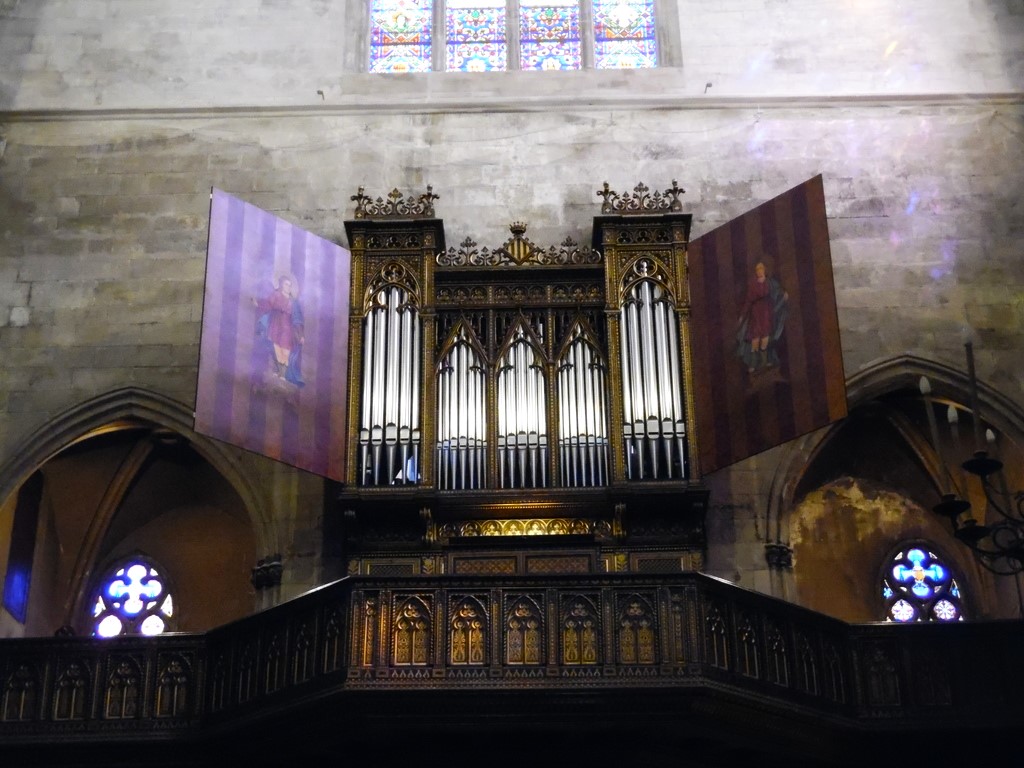Barcelona, Basílica dels Sants Màrtirs Just i Pastor
| Builder | M. Beltran |
|---|---|
| Year | ca. 1909 |
| Period/Style | Romantic |
| Stops | 28 |
| Keyboards | 2+P |
| Keyaction | tracker/mechanical |
| Sampleset |
Available
 , sampled by
Teclats.cat
, sampled by
Teclats.cat
|
The organ in the Basílica dels Sants Màrtirs Just i Pastor in Barcelona is a historically significant instrument that incorporates elements from various periods, ranging from the late medieval to the Romantic era. This unique organ survived the Spanish Civil War, which devastated many organs in Catalonia, making it a rare and valuable example of historical organ building.
Originally constructed by Miquel Beltran between 1906 and 1909, the organ includes materials from the 17th, 18th, and 19th centuries, along with new elements added during its construction. The organ has 28 stops and 1,871 pipes, showcasing a blend of Baroque and Romantic characteristics. The organ underwent significant restoration in 2016 by Albert Blancafort, which included adding approximately 200 new pipes and preserving the instrument's historical integrity. The restoration aimed to bring back its original brilliance and functionality, allowing it to be used for liturgical purposes and concerts once again.
This organ's preservation is particularly notable because it is one of the few historical organs in Barcelona that survived the Civil War intact. Its unique combination of different historical elements and its comprehensive restoration make it a significant cultural and musical asset for the city, now used regularly for both religious services and public concerts.
Originally constructed by Miquel Beltran between 1906 and 1909, the organ includes materials from the 17th, 18th, and 19th centuries, along with new elements added during its construction. The organ has 28 stops and 1,871 pipes, showcasing a blend of Baroque and Romantic characteristics. The organ underwent significant restoration in 2016 by Albert Blancafort, which included adding approximately 200 new pipes and preserving the instrument's historical integrity. The restoration aimed to bring back its original brilliance and functionality, allowing it to be used for liturgical purposes and concerts once again.
This organ's preservation is particularly notable because it is one of the few historical organs in Barcelona that survived the Civil War intact. Its unique combination of different historical elements and its comprehensive restoration make it a significant cultural and musical asset for the city, now used regularly for both religious services and public concerts.
| I Manual | II Manual | Pedal |
|---|---|---|
| Bordo 16' | Bordo 8' | Contres 16' |
| Bordo 8' | Viola de Gamba | Contres 8' |
| Flautat | Veu Celeste | Coral 4' |
| Flauta Harmonica | Octava | |
| Flauta Traverssera | Fagot Oboe | |
| Octava | Corn Anglais | |
| Quinzena | Veu Humana | |
| Plens 13a (?) | ||
| Plens 15a (?) | ||
| Tapadet | ||
| Nasard 15a (?) | ||
| Nasard 12a | ||
| Corneta | ||
| Trompeta angelica | ||
| Clari | ||
| Baixons/Clarins | ||
| Trompeta Magna | ||
| Trompeta Real |
No Video/Audio samples available.
https://www.atmos.cat/perl?num=1527818051
https://catalonianpipeorgans.blogspot.com/2015/06/77-orgue-de-la-basilica-dels-sants.html
https://ca.wikipedia.org/wiki/Orgue_de_l%27esgl%C3%A9sia_dels_Sants_Just_i_Pastor
https://catalonianpipeorgans.blogspot.com/2015/06/77-orgue-de-la-basilica-dels-sants.html
https://ca.wikipedia.org/wiki/Orgue_de_l%27esgl%C3%A9sia_dels_Sants_Just_i_Pastor
 Pipe Organ Map
Pipe Organ Map